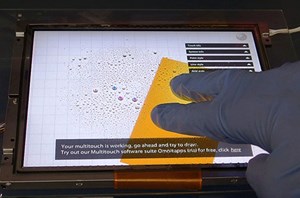Mar 30 2015
Leading LCD supplier Tianma NLT America is introducing a new touch screen technology developed by NLT Technologies, Ltd. The company's new 8.4-inch XGA is an amorphous-silicon thin-film-transistor (TFT) liquid crystal display (LCD) module with a "Wet & Glove" PCAP (projected capacitive) touch sensor bonded to the front.
This enables operation even when the screen is wet and/or the operator is wearing gloves. It provides dry screen tracking, water buildup tracking and single glove operation, even in a wet environment. It can also be used with medical grade defibrillator gel and ultrasound gel.

PCAP touch panels are being adopted in a rapidly expanding range of industrial equipment for the superior features they provide, such as flush surface designs, multi-touch functionality and gesture operation. This trend is particularly notable in display-based devices for use in special environments – such as outdoor equipment or medical devices or marine appliances, for example – where the touch panel could easily get wet or have medicines and other liquids spilled on it, and might also need to be operated by someone wearing gloves. However, these conditions would pose a problem for the position detection method used in conventional PCAP touch panels, which cannot function properly when used by a gloved user or while the screen is wet.
Key features of the new LCD incorporating Wet & Glove touch panel technology include:
(1) Combination of two detection methods
Touch coordinates are detected using a combination of mutual-capacitance and self-capacitance sensors. This enables the touch position to be detected with high precision even when the screen is wet and the user is wearing gloves, so the panel can also support multi-touch functionality and gesture operation. Although the two position detection methods – self-capacitance and mutual-capacitance – are available for use in conventional PCAP touch panels, the one typically used is the mutual-capacitance method, which supports multi-touch functionality. With this method, however, the detection capacitance changes when droplets of water or other liquids come in contact with the screen, so position detection becomes less precise when the screen is wet. Furthermore, when the operator is wearing thick gloves, detection sensitivity decreases. In contrast, the self-capacitance method is not affected by the change in capacitance caused by water droplets, so high precision detection is still possible when the screen is wet; however, supporting multi-touch functionality presents a problem. By combining mutual-capacitance and self-capacitance sensors, Wet & Glove technology eliminates these limitations.
(2) Proprietary sensitivity adjustment tool enables operation while wearing thick gloves\
Thanks to sensitivity adjustment, using a proprietary touch panel controller developed by NLT, the panel can be used even by an operator wearing thick gloves. Accurate position detection is still possible even when the screen is wet and the user is wearing 2mm thick gloves.
(3) Wide variety of design specifications accommodated
Wet & Glove touch technology also supports various design options, such as bonding method or surface treatments. Treatments to protect against fingerprints or reduce glare, for example, are accommodated, so end-product designers can set specifications to suit a broad range of usage scenarios.
By meeting market demands under the rigorous conditions imposed by a variety of industrial and medical usage scenarios, this new Wet & Glove technology will contribute to broadening the scope of applications for PCAP touch panels, as well as adding higher value to customer applications.
A prototype of an LCD module applying the new Wet & Glove technology will be showcased at Display Week 2015 in San Jose, California, June 2-4, in Booth 917.
For more information, contact Tianma NLT America, Inc., 2801 Scott Blvd., Santa Clara, CA 95050. 1-408-816-7010; [email protected]; www.tianma-nlt.com.